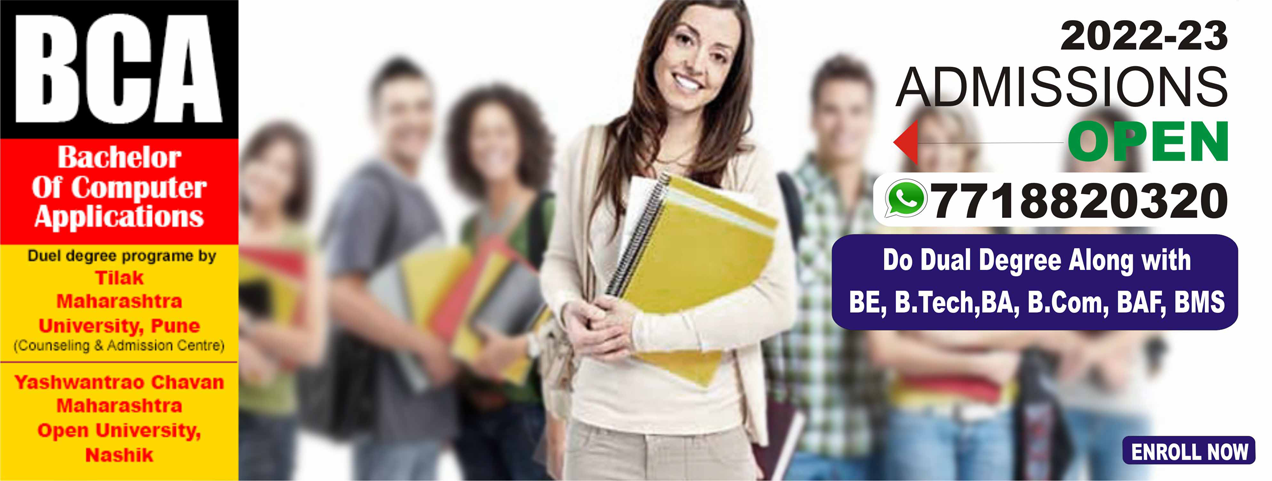DISTANCE EDUCATION
WHAT?
Today two terms that are being used almost inter-changeably are ‘Open Learning’ and ‘Distance Education’ and they are often combined to be known as Open and Distance Learning (ODL). Open learning is a philosophy and Distance Education is the mode used for translating it into reality as the two are complementary to each other.
Distance Education (DE) is an umbrella term which describes all the teaching learning arrangements in which the learner and the teacher are separated by space and time. In fact it is a mode of delivering education and instruction to learners who are not physically present in a traditional setting of a classroom. Transaction of the curriculum is effected by means of specially prepared materials (self-study (learning) materials) which are delivered to the learners at their doorstep through various media such as print, television, radio, satellite, audio/video tapes, CD-ROMs, Internet and World Wide Web etc. Also a technological medium replaces the inter-personal communication of conventional classroom based education that takes place between the teacher and the learners. Communication between the institution, teacher and learners is mainly through electronic media (telephone, interactive radio counselling, teleconferencing, videoconferencing, chat sessions, email, website etc) and also through postal correspondence and limited face to face contact sessions held at Study Centres that are set up by the DE institutions as close to the learners’ homes as possible. Open Learning Open learning, which covers a wide range of innovations and reforms in the educational sector that advocates flexibility to the learner with regard to entry and exit; pace and place of study; method of study and also the choice and combination of courses; assessment and course completion. The lesser the restrictions, the higher the degree of openness. The Open learning system aims to redress social or educational inequality and to offer opportunities not provided by conventional colleges or universities. Educational opportunities are planned deliberately so that access to education is available to larger sections of the society. Thus, ODL is a term which accepts the philosophy of “openness” and uses the “distance mode” of learning
WHY?
ODL occupies a special place in the Indian higher education system because of its major contribution in enhancing the gross enrollment ratio and democratization of higher education to large segments of the Indian population particularly to reach out to the unreached and to meet the demands of lifelong learning which has become more of a necessity in the knowledge society. The major objectives of DE system are:
- To democratize higher education to large segments of the population, in particular the disadvantaged groups such as those living in remote and rural areas, working people, women etc.
- To provide an innovative system of university-level education which is both flexible and open in terms of methods and pace of learning; combination of courses, eligibility for enrollment, age of entry, conduct of examination and implementation of the programmes of study.
- To provide an opportunity for up-gradation of skills and qualifications; and . To develop education as a lifelong activity to enable persons to update their knowledge or acquire knowledge in new areas.
HOW?
India has one of the largest DE systems in the world, second only to China. There are six types of
institutions offering DE today:
- National Open University
- State Open Universities
- Distance Education Institutions (DEIs) at-
- Institutions of National Importance
- Central Universities
- State Universities
- Deemed to be Universities
- State Private Universities
- DEIs at Stand alone Institutions
- Professional Associations
- Government Institutions
- Private institutions
Historical Developments
Five decades ago policy-makers realized the imperative need of DE in order to expand the base of higher
education. With the expanding base at the elementary and secondary education levels, the demand for higher
education had increased. The University Grants Commission (UGC) suggested in its report for 1956-1960
that proposals for evening colleges, correspondence courses and award of external degrees should be
considered. The Planning Commission took serious note of such a need and in its Third Five Year Plan
mentioned the need for the introduction of correspondence education in the country. In the light of the
observations made by the Planning Commission the Central Advisory Board on Education recommended the
setting up of an Expert Committee under the chairmanship of Dr. D.S. Kothari, the then Chairman of UGC,
to look into the proposal of introducing correspondence courses. The Expert Committee recommended the
institution of correspondence courses in view of the greater flexibility, economic viability and innovative
methods of imparting education. The committee also suggested that correspondence courses in India should
be administered by the universities only and in the first instance, by one University, viz., the University of
Delhi as a pilot project.
- Thus was born in 1962 the University of Delhi’s School of Correspondence Courses and Continuing
Education. Subsequently the Education Commission (1964-66), under the chairmanship of Dr. D.S.
Kothari, also perceived correspondence education as an answer to the increasing pressure of numbers
as well as the growing financial pressures on the universities. - The next decade i.e. the 1970s saw the growth and spread of the Correspondence Education system
in India, by more conventional universities opening Correspondence Course Institutes (subsequently
renamed as Directorates of Distance Education/ Centres of Distance Education ). - The opportunity of access, affordability and convenience offered by the DE system contributed to its
increasing popularity and growth. But again the DE system was plagued by the rigidities of the
conventional system. The only flexibility was with regard to the larger number of seats. Education
was still out of the reach of the marginalized and the disadvantaged. .It was realized that unless we
open educational opportunities to the deprived, unless we remove the structural rigidities in our
educational system and unless we integrate the educational system with developments in
communication technology, we cannot and will not make headway in realizing the uphill task of
educating majority of the people and of catering to the diverse types of education that a modern
society demands - Against this background the government introduced the Open University system in the 1980s, with
the objective to further democratize opportunities for higher education to large segment of the Indian
population, particularly those for whom access was difficult or impossible such as those living in
remote and rural areas, working people, women and other adults who wish to acquire and upgrade
their knowledge and skills through studies in various fields. - The Ministry of Human Resource Development in its National Policy on Education (NPE) 1986,
gave prominence to an OU system as a means to “augment opportunities for higher education and as
an instrument of democratizing education” Clearly, the vision was that OUs would be different from
conventional universities. - Thus a new chapter in DE system began with the establishment of Dr BR Ambedkar Open
University, Hyderabad in 1982, followed by the establishment of Indira Gandhi National Open
University at the national level by the Parliament of India in 1985. The idea was accepted by many
states and 1987 saw the emergence of two more Open Universities, namely, Nalanda Open
University (NOU) Patna, Bihar and Vardhman Mahaveer Open University (VMOU), Kota,
Rajasthan. Subsequently, Yashwantrao Chavan Maharashtra Open University (YCMOU), Nashik,
Maharashtra was established in 1989. - The major responsibility for the promotion and coordination of Open and DE was bestowed by the
Parliament on the Indira Gandhi National Open University (IGNOU), instead of the UGC, the
statutory authority for regulating higher education India. Thus IGNOU became a unique institution
as it was entrusted with a dual role: of functioning like an Open University by offering programmes
of education and training through distance mode and also acting as the promoter, coordinator of the
Open and Distance Education system in the country and determining standards in such systems. To
fulfil this particular mandate the Distance Education Council (DEC) was set up by IGNOU in 1991
as a statutory mechanism under IGNOU Act which became operational in February 1992. The DEC
functioned within the broad framework, and the policies laid down by the Board of Management of
IGNOU while enjoying a significant measure of autonomy in its operations. - As per the mandate of the DEC and the NPE 1986, which was revised in 1992, the DEC started
interacting with the State Governments for establishing the SOUs in the respective states. As a result
of DEC initiatives several State governments established Open Universities. As emphasized in the
NPE of 1986 and subsequently Programme of Action in 1992, the OUs adopted a radically different
approach to reach the disadvantaged by adopting a variety of media and delivery channels for
dissemination of information and knowledge. As a result of this they have been able to make a
definite impact on society, and more Indians have access to higher education than ever before. - The Distance Education Council (DEC) took several initiatives for promotion, coordination and
maintenance of standards of open and distance education system in the country. DEC has developed
guidelines for regulating the establishment and operation of ODL institutions in the country. - In August 2010, the Ministry of Human Resource Development constituted a Committee under the
Chairmanship of Prof. Madhava Menon in respect of regulation of standards of education imparted
through distance mode. - In view of the acceptance of the Report submitted by the Madhava Menon Committee by the Ministry of
Human Resource Development (MHRD) and its recommendations for the creation of a new regulatory
body for ODL system, the Distance Education Council of India (DECI). The Madhava Menon
Committee also decided that as an interim measure, the DEC of IGNOU may be shifted to UGC. - Subsequently, the MHRD issued an order, dated 29th December, 2012, transferred the regulatory
authority of distance education from IGNOU to UGC. Thereafter, IGNOU notified the repeal and
deletion of Statute 28 of IGNOU Act and dissolution of DEC on 1st May 2013. UGC issued an order
taking over the physical infrastructure of erstwhile DEC on “as is where is basis” and the staff
working at erstwhile DEC on “deemed deputation basis”. This is an interim measure till such time an
independent body namely Distance Education Council of India is created by the Parliament.







 1
1 2
2 3
3 4
4 5
5 6
6